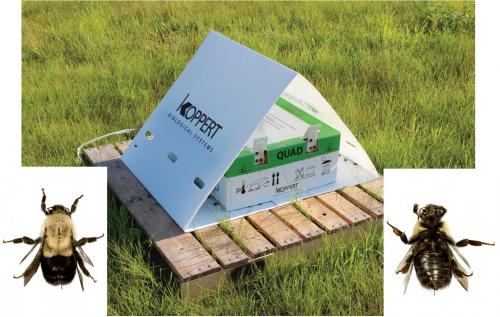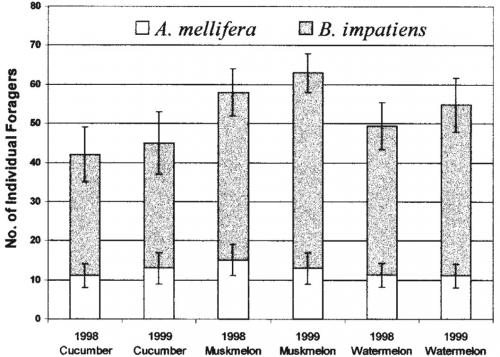Bumble bee pollination trials in vine crops
With honey bee declines recorded around the world, how do bumble bees compare on outdoor vine crops?
Bumble bees in cucumbers and watermelons
In North Carolina, researchers limited pollination of cucumber (Cucumis sativus) and watermelon (Citrullus lanatus) flowers (‘Calypso’) to zero, one, six, 12 and 18 visits per flower from honey bees and bumble bees, respectively, and compared that to flowers left open to unhindered visits. They found that increased visits from both bees resulted in fewer abortions and higher seed set, but bumble bees consistently out-performed honey bees (Table 1). Follow-up studies further discovered that when provided two bumble bee colonies and two honey bee colonies, more bumble bees were observed in the crop, and they visited twice as many flowers per minute as honey bees (Figure 1).
Table 1. Controlled increments of honey bee and bumble bee visits to cucumber, watermelon measuring fruit abortion and seed set. Significant differences from the open-control are denoted by *. Controlled increments of honey bee and bumble bee visits to pumpkin flowers measuring fruit set.
|
Bee type |
Visits (#) |
Cucumber |
Watermelon |
Pumpkin |
|||||||
|
Calypso |
Dasher II |
Royal Jubilee |
Mystic Plus |
||||||||
|
Fruit abortion (%) |
Mean seed set |
Fruit abortion (%) |
Mean seed set |
Fruit abortion (%) |
Mean seed set |
Visits (#) |
2008 Fruit set (%) |
2009 Fruit set (%) |
2010 Fruit set (%) |
||
|
No-visit control |
… |
100* |
0* |
100* |
0* |
100.0* |
0* |
… |
0 |
0 |
0 |
|
Honey bee |
1 |
60* |
175* |
55* |
126* |
73.3* |
171* |
1 |
23.8 |
7.7 |
23.1 |
|
Bumble bee |
1 |
50* |
259* |
50* |
164* |
55.0* |
235* |
1 |
13.3 |
44.4 |
64.7 |
|
Honey bee |
6 |
45* |
250* |
40* |
192* |
53.3 |
217* |
2 |
50 |
0 |
26.7 |
|
Bumble bee |
6 |
20* |
291* |
30* |
220 |
51.7 |
251* |
2 |
61.1 |
85.7 |
75 |
|
Honey bee |
12 |
25* |
386 |
20* |
197* |
48.3 |
233* |
4 |
78.3 |
28.6 |
50 |
|
Bumble bee |
12 |
25* |
416 |
20* |
216 |
50 |
287 |
4 |
77.8 |
100 |
92.3 |
|
Honey bee |
18 |
20* |
254* |
10 |
197 |
50 |
279 |
8 |
- |
63.6 |
85.7 |
|
Bumble bee |
18 |
15* |
430 |
10 |
240 |
45 |
322 |
8 |
- |
100 |
100 |
|
Open-control |
… |
5 |
430 |
10 |
243 |
43.3 |
305 |
… |
88 |
100 |
100 |

Figure 1. Bumble bee quad with shade structure and pallet to mitigate heat, water and pest stresses. Quads are boxes containing four individual bumble bee colonies (photo by Koppert Biological Systems). Insets of Bombus impatiens (Julie Ducharme).
In another study, researchers investigated if bumble bees placed in pickling cucumbers and watermelon were affected by temperature conditions by constructing shade structures for them in 2011 and 2012 in Delaware (Figure 2). The results showed that shade structures had a positive effect on colony foraging activity and weight in both years for bees in watermelon, and one year for bees in cucumbers. Otherwise they spent more time thermo-regulating the hive than foraging.

Figure 2. The bar chart above shows the numbers of foraging honey bees and bumble bees observed in cucumber, muskmelon and watermelon when two hives of each species were stocked nearby.
In 2012, shaded and unshaded bumble bee hives in cucumbers did not appear to forage on the cucumber flowers, quickly lost weight, and suffered from blowing away in the wind and honey bee raids. There was not an appreciable or practical effect on yields of either crop, though there were more 3b cucumbers only in 2011 within a 20-foot vicinity of the hives placed in the middle of fields.
Bumble bees in muskmelon and cantaloupes
In Ohio, naturally-occurring honey bees and bumble bees in muskmelons (Cucumis melo) were not different in their pollen deposition to female flowers, but bumble bees removed more pollen from male flowers than honey bees and spent more time in flowers. Therefore, bumble bees would be more efficient pollinators of these crops if their visitation frequency were higher than honey bees. In North Carolina, this was observed when two colonies of each species were placed near experimental muskmelon fields.
Bumble bees in pumpkins, zucchini and squash
When comparing the performance of honey bees and bumble bees visiting pumpkin flowers, researchers in New York found that honey bees spent two to three times longer in flowers and visited flowers 10 to 20 times more frequently. They also limited pollination of pumpkin flowers (‘Mystic Plus’) to zero, one, two, four and eight visits per flower from honey bees and bumble bees, respectively, and compared that to flowers left open to unhindered visits. They found that bumble bees deposited three times more pollen grains on an individual visit, which improved fruit set, fruit weight and seed set.
Bumble bees outperformed honey bees in this controlled experiment. However, in a follow up study in New York, researchers were unable to detect any fruit weight, seed set or yield differences when comparing pumpkin fields supplemented with only honey bees (0.5 hives per acre), only bumble bees (two quads per acre) and unsupplemented fields.
References
- Using commercial bumble bee colonies as backup pollinators for honey bees to produce cucumbers and watermelons, HortTechnology
- Pollen mobilization in selected Cucurbitaceae and the putative effects of pollinator abundance on pollen depletion rates, American Society for Horticultural Science
- Diurnal activity, floral visitation and pollen deposition by honey bees and bumble bees on field-grown cucumber and watermelon, Journal of Apicultural Research
- The development of best management practices of commercial bumble bees (Hymenoptera: Apidae) on horticultural crops in Delaware, University of Delaware
- Influence of bee species (Hymenoptera : Apiformes) with contrasting behaviors on pollen movement in a mustard, Brassica rapa (Brassicaceae) and the muskmelon Cucumis melo (Cucurbitaceae), Entomologia Generalis
- Performance of Apis mellifera, Bombus impatiens, and Peponapis pruinosa (Hymenoptera: Apidae) as pollinators of pumpkin, Journal of Economic Entomology
- Pollination Services Provided by Bees in Pumpkin Fields Supplemented with Either Apis mellifera or Bombus impatiens or Not Supplemented, Plos One



 Print
Print Email
Email



